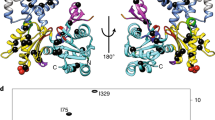Abstract
Conformational changes within myosin lead to its movement relative to an actin filament. Several crystal structures exist for myosin bound to various nucleotides, but none with bound actin. Therefore, the effect of actin on the structure of myosin is poorly understood. Here we show that the swing of smooth muscle myosin lever arm requires both ADP and actin. This is the first direct observation that a conformation of myosin is dependent on actin. Conformational changes within myosin were monitored using fluorescence resonance energy transfer techniques. A cysteine-reactive probe is site-specifically labeled on a 'cysteine-light' myosin variant, in which the native reactive cysteines were removed and a cysteine engineered at a desired position. Using this construct, we show that the actin-dependent ADP swing causes an 18 Å change in distance between a probe on the 25/50 kDa loop on the catalytic domain and a probe on the regulatory light chain, corresponding to a 23° swing of the light-chain domain.
This is a preview of subscription content, access via your institution
Access options
Subscribe to this journal
Receive 12 print issues and online access
$189.00 per year
only $15.75 per issue
Buy this article
- Purchase on Springer Link
- Instant access to full article PDF
Prices may be subject to local taxes which are calculated during checkout





Similar content being viewed by others
References
Rayment, I. et al. Structure of the actin–myosin complex and its implications for muscle contraction. Science 261, 58–65 (1993).
Dominguez, R., Freyzon, Y., Trybus, K.M. & Cohen, C. Crystal structure of a vertebrate smooth muscle myosin motor domain and its complex with the essential light chain: visualization of the pre-power stroke state. Cell 94, 559–571 (1998).
Houdusse, A., Kalabokis, V.N., Himmel, D., Szent-Györgyi, A.G. & Cohen, C. Atomic structure of scallop myosin subfragment S1 complexed with MgADP: a novel formation of the myosin head. Cell 97, 459–470 (1999).
Volkmann, N. et al. Evidence for cleft closure in actomyosin upon ADP release. Nat. Struct. Biol. 7, 1147–1155 (2000).
Whittaker, M. et al. A 35 Å movement of smooth muscle myosin on ADP release. Nature 378, 748–751 (1995).
Gollub, J., Cremo, C.R. & Cooke, R. ADP release produces a rotation of the neck region of smooth myosin but not skeletal myosin. Nat. Struct. Biol. 3, 796–802 (1996).
Selvin, P.R. Principles and biophysical applications of luminescent lanthanide probes. Annu. Rev. Biophys. Biomol. Struct. 31, 275–302 (2002).
Rayment, I. et al. Three-dimensional structure of myosin subfragment-1: a molecular motor. Science 261, 50–57 (1993).
Shih, W.M., Gryczynski, Z., Lakowicz, J.R. & Spudich, J.A. A FRET-based sensor reveals large ATP hydrolysis-induced conformational changes and three distinct states of the molecular motor myosin. Cell 102, 683–694 (2000).
Houdusse, A., Szent-Gyorgyi, A.G. & Cohen, C. Three conformational states of scallop myosin S1. Proc. Natl. Acad. Sci. USA 97, 11238–11243 (2000).
Houdusse, A. & Sweeney, H.L. Myosin motors: missing structures and hidden springs. Curr. Opin. Struct. Biol. 11, 182–194 (2001).
Hopp, T.P. et al. A short polypeptide marker sequence usefulfor recombinant protein identification and purification. Biotechnology 6, 1205–1210 (1988).
O'Reilly, D.R., Miller, L.K. & Luckow, V.A. Baculovirus Expression Vectors: a laboratory manual (W.H. Freeman and Company, New York, New York; 1992).
Sweeney, H.L. et al. Kinetic tuning of myosin via a flexible loop adjacent to the nucleotide binding pocket. J. Biol. Chem. 273, 6262–6270 (1998).
Pollard, T.D. Assays for myosin. Methods Enzymol. 85, 123–130 (1982).
White, H.D. Special instrumentation and techniques for kinetic studies of contractile systems. Methods Enzymol. 85, 698–708 (1982).
Chen, J. & Selvin, P.R. Thiol-reactive luminescent lanthanide chelates. Bioconjugate Chem. 10, 311–315 (1999).
Selvin, P.R., Jancarik, J., Li, M. & Hung, L.-W. Crystal structure and spectroscopic characterization of a luminescent europium chelate. Inorgan. Chem. 35, 700–705 (1996).
Xiao, M. et al. Conformational changes between the active-site and regulatory light chain of myosin as determined by luminescence resonance energy transfer: The effect of nucleotides and actin. Proc. Natl. Acad. Sci. USA 95, 15309–15314 (1998).
Xiao, M. & Selvin, P.R. An improved instrument for measuring time-resolved lanthanide emission and resonance energy transfer. Rev. Sci. Instrum. 70, 3877–3881 (1999).
Clegg, R.M., Murchie, A.I., Zechel, A. & Lilley, D.M. Observing the helical geometry of double-stranded DNA in solution by fluorescence resonance energy transfer. Proc. Natl. Acad. Sci. USA 90, 2994–2998 (1993).
Vamosi, G., Gohlke, C. & Clegg, R. Fluorescence characteristics of 5-carboxytetramethylrhodamine linked covalently to the 5′ end of oligonucleotides: multiple conformers of single-stranded and double-stranded dye-DNA complexes. Biophys. J. 71, 972–994 (1996).
Xiao, M. & Selvin, P.R. Quantum yields of luminescent lanthanide chelates and far-red dyes measured by resonance energy transfer. J. Am. Chem. Soc. 123, 7067–7073 (2001).
Lakowicz, J.R. Principles of Fluorescence (Kluwer Academic, New York; 1999).
Acknowledgements
This work was supported by NIH grants to P.R.S. and H.L.S.
Author information
Authors and Affiliations
Corresponding authors
Ethics declarations
Competing interests
The authors declare no competing financial interests.
Rights and permissions
About this article
Cite this article
Xiao, M., Reifenberger, J., Wells, A. et al. An actin-dependent conformational change in myosin. Nat Struct Mol Biol 10, 402–408 (2003). https://doi.org/10.1038/nsb916
Received:
Accepted:
Published:
Issue Date:
DOI: https://doi.org/10.1038/nsb916
This article is cited by
-
Initial activation of STIM1, the regulator of store-operated calcium entry
Nature Structural & Molecular Biology (2013)
-
Comparison of all-atom and coarse-grained normal mode analysis in the elastic network model
Journal of Mechanical Science and Technology (2013)



